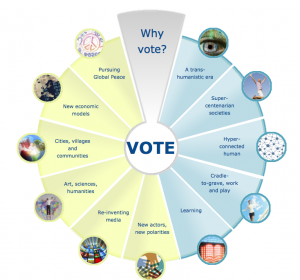
7 Nov, 2013
To Shape Policy Agenda, EC invites votes on what Europe could look like in 2050
Brussels, 5 November 2013 (European Commission Media Release) – What future do you want? In 2050, will the economy be fundamentally altered because home 3D printers mean you can press a button to print your own clothes, a new sofa or kitchen table? Will cancer be a thing of the past thanks to nano-robots which can detect and destroy tumours? What will society look like when many live to over 100 years old?
Vice-President Neelie Kroes, responsible for the Digital Agenda, is inviting people to join a voting and ranking process on 11visions of what the world could look like in 20-40 years. The Commission is seeking views on living and learning, leisure and working in Europe in 2050, to steer long-term policy or research planning.
The visions have been gathered over the past year through the Futurium, an online debate platform that allows policymakers to not only consult citizens, but to collaborate and “co-create” with them, and at events throughout Europe. Thousands of thinkers – from high school students, to the Erasmus Students Network; from entrepreneurs and internet pioneers to philosophers and university professors, have engaged in a collective inquiry – a means of crowd-sourcing what our future world could look like.
Eleven over-arching themes have been drawn together from more than 200 ideas for the future. From today, everyone is invited to join the debate and offer their rating and rankings of the various ideas. The results of the feedback will help the European Commission make better decisions about how to fund projects and ideas that both shape the future and get Europe ready for that future.
The full list of themes is available on the Futurium website and the voting process runs until the end of November 2013.
People are invited to rate each vision on its relevance (i.e. how great an impact will this future have on my life) and likely timing (i.e. how soon is this likely to happen). They can express how enthusiastic they are about each of the possible scenarios. For example: smart cities that are environmentally sustainable and energy efficient by 2050; a world where art and creativity will enter new markets and fields such as medical technology and synthetic biology; a world where the spread of the Internet of Things, cloud computing, supercomputing and big data will transform how national and local governments can make decisions, such as where to build a new airport or how to improve healthcare services.
These visions for the future will be featured at ICT 2013, Create Connect Grow in Vilnius on Friday 8th November.
Robert Madelin, Director General of DG CONNECT, said: “This approach works, it is a tried and tested and good value investment. I invite all decision-making bodies, from town councils to national governments, to adopt tools like the Futurium. These will allow them to better engage with their stakeholders and build evidence for future policy choices. Knowledge harnessed locally could then be cross-fertilised to better inform policy-making at all levels”.
Background
The Futurium
The Futurium is a foresight project run by DG CONNECT, based on an open source approach. It develops visions of society, technologies, attitudes and trends in 2040-2050 and use these, for example as potential blueprints for future policy choices or EU research and innovation funding priorities.
It is an online platform developed to capture emerging trends and enable interested citizens to co-create compelling visions of the futures that matter to them.
This crowd-sourcing approach provides useful insights on:
- Vision: where people want to go, how desirable and likely are the visions posted on the platform;
- Policy ideas: what should ideally be done to realise the futures; the possible impacts and plausibility of policy ideas;
- Evidence: scientific and other evidence to support the visions and policy ideas.
How can the Futurium help future policy making?
Scientific evidence to underpin policy making: digital models of the real world will make it possible to simulate the impact of future policies before their actual implementation, just as researchers and innovators model the effects of drugs or of aircraft pollution during the design phase.
Taking a scientific and forward-looking approach to policy making will lower costs and risks and improve the effectiveness and strategic basis for formulating and implementing public initiatives.
Connecting policy making to people: in an increasingly connected society, online outreach and engagement is an essential response to the growing demand for participation, helping to capture new ideas and to broaden the legitimacy of the policy making process (IP/10/1296). The Futurium is an early prototype of a more general policy-making model described in the paper “The Futurium—a Foresight Platform for Evidence-Based and Participatory Policymaking“.
The Futurium was developed to lay the groundwork for future policy proposals which could be considered by the European Parliament and the European Commission under their new mandates as of 2014. But the Futurium’s open, flexible architecture makes it easily adaptable to any policy-making context, where thinking ahead, stakeholder participation and scientific evidence are needed.
What the Futurium has shown us so far:
- As scientists, entrepreneurs or policy makers, we need to be courageous and make more use of the potential of disruptive innovation. The Horizon 2020 programme is our bridge into the future.
- Anticipation needs to become an important component of future policies.
- The Futurium is cost-effective prototype that can be enhanced and replicated in other private and public service setting to increase grassroots participation in policies, and to help “future proof” those policies
Useful Links
Vote for your vision of the Future
“The Futurium—a Foresight Platform for Evidence-Based and Participatory Policymaking”
Interview with Robert Madelin, Director-General, CONNECT, European Commission



Liked this article? Share it!